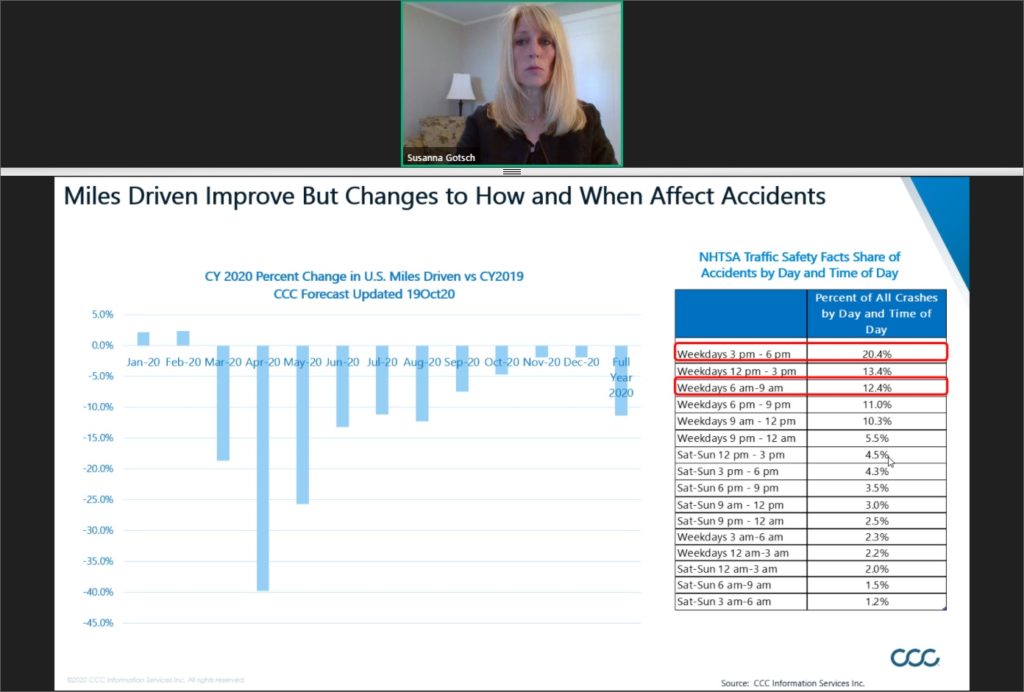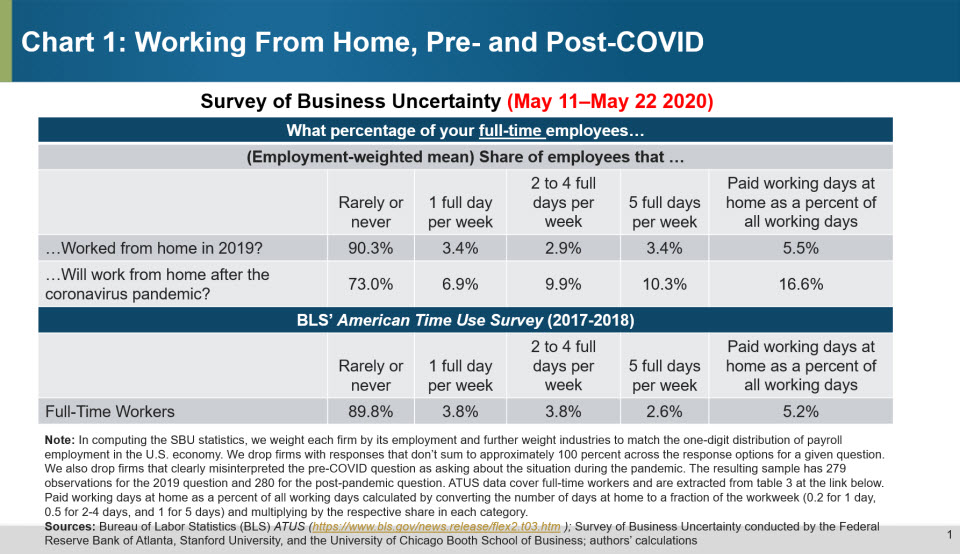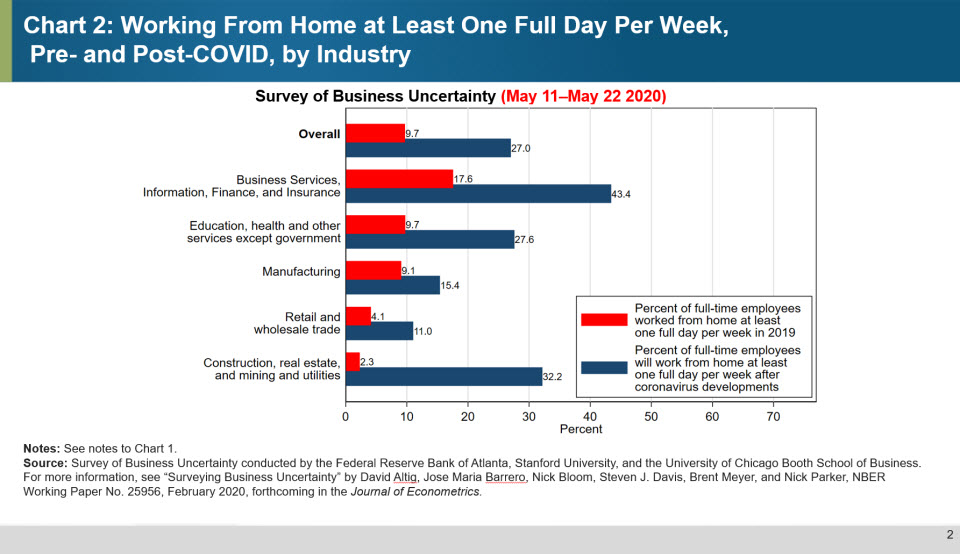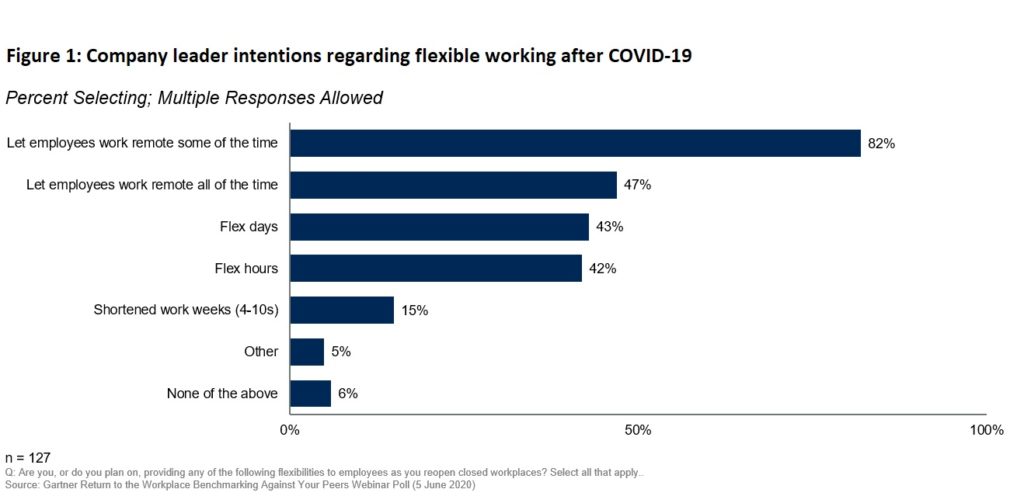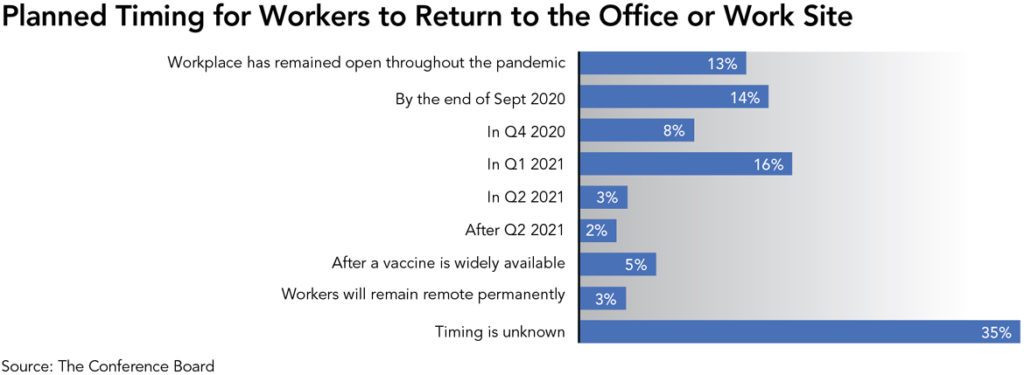
Work-from-home data offer new perspective on COVID-19 commuting recovery
By onAnnouncements | Business Practices | Education | Market Trends
CCC presentations this fall drew attention to means of studying an America with a new taste for working remotely.
The concepts raised by CCC analyst and director Susanna Gotsch and explored further by us in some instances here offer insight into what repairers might expect from commuter traffic, a key source of collision volume.
An important caveat: COVID-19 is a moving target, and so some of the views and projections here might have changed or should be adjusted based on positive news (vaccine success, reductions in cases and deaths, loosened lockdowns) and negative developments (new outbreaks and deaths, heightened lockdowns) that happened since. Pay close attention to the dates associated with the information and consider what might have happened since.
Nevertheless, the various research still seems to offer valuable intelligence on macro-level commuter trends repairers should consider.
Gotsch during the MSO Symposium Nov. 9 presented NHTSA statistics indicating most collisions (20 percent) occur between 3-6 p.m. Another 12.4 percent of crashes happen between 6 a.m. and 9 a.m., the third most likely time for an accident.
In other words, rush hours = crashes. Weekdays from noon to 3 p.m. represented the No. 2 most popular time for collisions, at 13.4 percent.
So as we’ve learned this year, Americans working from home could be a problem for body shops looking for work.
Gallup polling found found 33 percent of Americans “always” working remotely Sept. 14-27 — an improvement from the 51 percent in April that Gotsch had referenced during a Guild 21 call Oct. 8. The percentage of people who didn’t work remotely at all climbed from 31 percent in April to 42 percent in September.
Gallup said another poll found 52 percent of Americans reporting in April that either very few or no co-workers had returned to their workplace. By September, this had fallen to 23 percent. 42 percent of respondents in September said all or nearly all employees had come back to the office.
Gotsch on Nov. 9 also drew attention to the Kastle Back to Work Barometer, which examines employee usage of keycards, fobs and an app to open doors at its 41,000 client workplaces.
That data wasn’t as strong as the Gallup findings. Kastle reported that for the week including Dec. 2, the 10-city average business occupancy rate was 24.4 percent, better than the Thanksgiving holiday week but still down from 27 percent the week of Nov. 10.
Gotsch said Oct. 8 that while miles driven have been slowly returning to pre-pandemic levels, the nature of that driving is changing. She said CCC’s telematics data indicates less rush-hour traffic; instead, the roads are encountering “more constant traffic.”
As of Oct. 19, CCC projected that miles driven for the year would end up down around 11 percent.
That’s sort of where things sit today in America’s businesses. But what about the future?
Future working from home
Jonathan I. Dingel and Brent Neiman of the University of Chicago Business School, National Bureau of Economic Research and Center for Economic Policy Research in June estimated in June estimated “37 percent of jobs in the United States can be performed entirely at home, with significant variation across cities and industries.” Gotsch appeared to reference this statistic in a slide from her Oct. 8 talk.
Employers aren’t ready to go as far as that — but they are anticipating more working from home even after the pandemic ends.
Business polling by the Atlanta Federal Reserve Bank, Stanford and the University of Chicago Business School between May 11-22 revealed that only 9.7 percent of employees worked a full day or more from home weekly in 2019. Only 3.4 percent worked five days a week at home, according to the study Gotsch highlighted Oct. 8.
But the same employers estimated that 27 percent of staff would work from home at least one full day once the pandemic ends — and 10.3 percent would spend five days a week working from home.
Both of Gotsch’s presentations showed a breakdown of the results by sector, with the research revealing some significant spikes in certain groupings of industries. Most notable seemed to be the subset made up of “Construction, real estate, and mining and utilities” companies. Those businesses estimated only 2.3 percent of employees worked at least a day from home in 2019 — but felt 32.2 percent would do so post-pandemic.
A different study conducted in June by Gartner and presented by Gotsch during both talks found 82 percent of company leaders would allow at least some remote work as their businesses reopened.
“Nearly half (47%) said they intend to allow employees to work remotely full time going forward,” Gartner wrote in a July 14 news release.
It’s unclear if these companies meant they would allow this in perpetuity or just through the remainder of the pandemic, but the results seem noteworthy nonetheless.
“The COVID-19 pandemic brought about a huge experiment in widespread remote working,” Gartner human resources practice advisory Vice President Elisabeth Joyce said in a statement. “As business leaders plan and execute reopening of their workplaces, they are evaluating more permanent remote working arrangements as a way to meet employee expectations and to build more resilient business operations.”
Employers also displayed confidence in their employees. Gartner found that while 61 percent of the leaders had instituted “more frequent manager-employee check-ins,” only 13 percent actually were concerned about productivity. Twenty-nine percent weren’t even tracking remote productivity.
Gotsch on Oct. 8 also offered insight on precisely how quickly employers would start recalling employers by presenting data from Aug. 19-26 Conference Board polling.
Contrary to the other remote working projections, only 3 percent of the executives and managers surveyed by the Conference Board felt their workers would stay remote permanently, though this might be indicating companies who would have literally every employee working from home in perpetuity.
22 percent expected to bring employees back by Sept. 31 or in the fourth quarter. 16 percent plan to recall employees in the first quarter of 2021, and 3 percent anticipated workers returning in the second quarter of 2021. Only 5 percent said they would wait for widespread vaccine availability.
The most common answer (35 percent) was that the employers simply didn’t know when employees would come back.
13 percent of the companies surveyed by the Conference Board had stayed open during the pandemic.
Employees like the idea of working remotely. Gallup found 35 percent of remote workers in September would like to keep working from home purely out of personal preference — not out of fears about catching COVID-19. Another 35 percent would prefer not to work remotely any more.
The remaining 30 percent polled said they also want to work remotely because they’re worried about COVID-19. They’ll be an interesting wild card with regards to traffic volume: Once widespread vaccination ends their COVID-19 fears, would they wish to return to the office or keep on working from home?
More information:
“COVID-19 and Remote Work: An Update”
Gallup, Oct. 13, 2020
“Survey: 35 Percent of US Companies Do Not Know When They’ll Reopen Workplace”
Conference Board, Sept. 3, 2020
Gartner, July 14, 2020
“Firms Expect Working from Home to Triple”
Federal Reserve Bank of Atlanta, May 28, 2020
Kastle Back to Work Barometer webpage
Morning traffic in Mountain View, Calif., on Sept. 9, 2019. (Andrei Stanescu/iStock)
Images:
CCC analyst and director Susanna Gotsch, top, presented to the Nov. 9, 2020, MSO Symposium CCC’s Oct. 19, 2020, projections of miles driven and National Highway Traffic Safety Administration data on when crashes occur. (CCC and NHTSA data provided by CCC; screenshot from virtual MSO Symposium)
Business polling by the Atlanta Federal Reserve Bank, Stanford and the University of Chicago Business School between May 11-22 revealed that only 9.7 percent of employees worked a full day or more from home weekly in 2019. But the same employers estimated that 27 percent of staff would work from home at least one full day once the pandemic ends. (Atlanta Federal Reserve Bank, Stanford and the University of Chicago Business School; Provided by Atlanta Fed)
Business polling by the Atlanta Federal Reserve Bank, Stanford and the University of Chicago Business School between May 11-22 revealed that only 9.7 percent of employees worked a full day or more from home weekly in 2019. But the same employers estimated that 27 percent of staff would work from home at least one full day once the pandemic ends. Some groups of industries revealed a significantly larger spread. (Atlanta Federal Reserve Bank, Stanford and the University of Chicago Business School; Provided by Atlanta Fed)
A study conducted in June 2020 by Gartner found 82 percent of company leaders would allow at least some remote work as their businesses reopened. (Provided by Gartner)
Aug. 19-26, 2020, Conference Board polling found 35 percent of executives and managers simply didn’t know when employees would come back. 22 percent expected to bring employees back by Sept. 31 or in the fourth quarter. (Provided by the Confidence Board)

